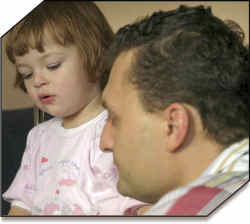 There’s a good chance that you yourself are part of a stepfamily. If you’re not, you almost certainly have close friends or family members who are. Statistics show that one in three Americans live in a stepfamily and that more than 50% of Americans will live in a stepfamily at some point in their lives. A term that is now commonly used to describe a family that forms after divorce or re-marriage is a “blended” family.
There’s a good chance that you yourself are part of a stepfamily. If you’re not, you almost certainly have close friends or family members who are. Statistics show that one in three Americans live in a stepfamily and that more than 50% of Americans will live in a stepfamily at some point in their lives. A term that is now commonly used to describe a family that forms after divorce or re-marriage is a “blended” family.
With so many Americans being a part of a “blended” family these days, it should come as no surprise that there is actually a day to celebrate being in a stepfamily…National Stepfamily Day! September 16 is the day that has been designated as the day to honor all the “Step Heroes” out there who choose every day to be parents to ALL the children in their lives.
In 1997, Christy Brogeld, who herself was a remarried mother and member of a blended family, decided that it was time to begin a campaign to bring stepfamily support and awareness to the nation’s attention. That year she got 24 states to officially make … Read More... “Did You Know that National Stepfamily Day is September 16th?”


 On July 1, 2011, the Domestic Relations Court of Montgomery County, Ohio adopted a “new” and “revised” Standard Order of Parenting Time, previously known as the Standard Order of Visitation. Over the years, our elected officials in Columbus, Ohio have chosen to “rename” terms frequently used in the Domestic Relations Court. The phrase “parenting time” replaces the older word of “visitation”, and, the term “parental rights and responsibilities” replaces the older word of “custody”. It should be noted that with each change in legislation, the older or former terms have been replaced with longer names or phrases!
On July 1, 2011, the Domestic Relations Court of Montgomery County, Ohio adopted a “new” and “revised” Standard Order of Parenting Time, previously known as the Standard Order of Visitation. Over the years, our elected officials in Columbus, Ohio have chosen to “rename” terms frequently used in the Domestic Relations Court. The phrase “parenting time” replaces the older word of “visitation”, and, the term “parental rights and responsibilities” replaces the older word of “custody”. It should be noted that with each change in legislation, the older or former terms have been replaced with longer names or phrases! When parents neglect or fail to provide even basic food, shelter, or medical care for their children, we would all agree that Children’s Services needs to step in and remove a child from their parent’s control. If a child’s immediate safety and well being are at risk, we would argue that such a situation must not be allowed to continue.
When parents neglect or fail to provide even basic food, shelter, or medical care for their children, we would all agree that Children’s Services needs to step in and remove a child from their parent’s control. If a child’s immediate safety and well being are at risk, we would argue that such a situation must not be allowed to continue. Alternative dispute resolution can be a wonderful tool in divorce cases. Montgomery County’s Domestic Relations Court, along with many other divorce Courts, have adopted mediation conferences as a voluntary or, in some cases, mandatory prerequisite to trial. I am focusing this article on how that process works in Montgomery County.
Alternative dispute resolution can be a wonderful tool in divorce cases. Montgomery County’s Domestic Relations Court, along with many other divorce Courts, have adopted mediation conferences as a voluntary or, in some cases, mandatory prerequisite to trial. I am focusing this article on how that process works in Montgomery County. A divorce often leads to many changes within a family. Recognizing this fact is extremely important, especially when children are involved. Divorcing parents should ask themselves each step of the way what they can do to minimize the negative impact on their children. Parental funding of a child’s college education often becomes a casualty in the process.
A divorce often leads to many changes within a family. Recognizing this fact is extremely important, especially when children are involved. Divorcing parents should ask themselves each step of the way what they can do to minimize the negative impact on their children. Parental funding of a child’s college education often becomes a casualty in the process. Even young children are aware that they are part of both parents. We tell them the story of our courtship, our wedding and of their birth. We show them baby pictures. “You have Daddy’s smile and you have Mommy’s eyes,” we tell them. This is one way children feel they are part of a family. It helps our children develop a sense of identity and belonging. As children grow older, we begin to identify more traits in them that remind us of ourselves. “You are artistic like your dad” or “you have your mom’s wit” are further ways we continue to build connection with our kids.
Even young children are aware that they are part of both parents. We tell them the story of our courtship, our wedding and of their birth. We show them baby pictures. “You have Daddy’s smile and you have Mommy’s eyes,” we tell them. This is one way children feel they are part of a family. It helps our children develop a sense of identity and belonging. As children grow older, we begin to identify more traits in them that remind us of ourselves. “You are artistic like your dad” or “you have your mom’s wit” are further ways we continue to build connection with our kids. In September of 2008, Ohio became one of the first states to make a Next of Kin registration program available to its residents. The Ohio state legislature established the program in response to situations where police and emergency personnel had been unable to locate or contact family members of people who had been fatally injured. Several accidents occurred where people had been severely injured but not killed instantly. Tragically, their relatives were unable to spend time with their injured relatives during their last hours due to the difficulty police had in identifying exactly who to notify.
In September of 2008, Ohio became one of the first states to make a Next of Kin registration program available to its residents. The Ohio state legislature established the program in response to situations where police and emergency personnel had been unable to locate or contact family members of people who had been fatally injured. Several accidents occurred where people had been severely injured but not killed instantly. Tragically, their relatives were unable to spend time with their injured relatives during their last hours due to the difficulty police had in identifying exactly who to notify.